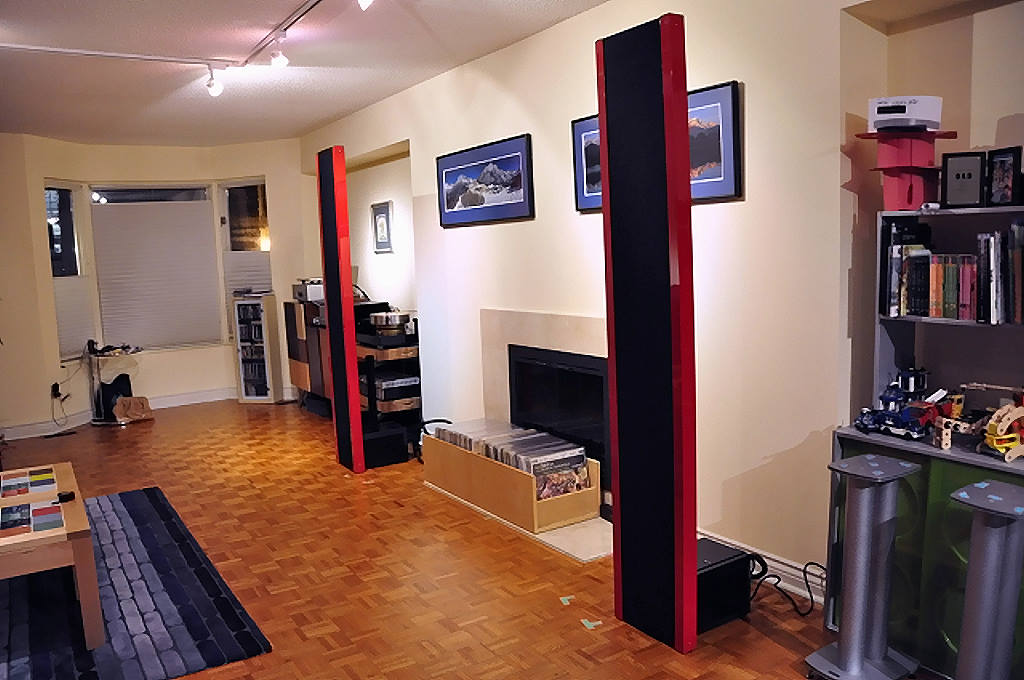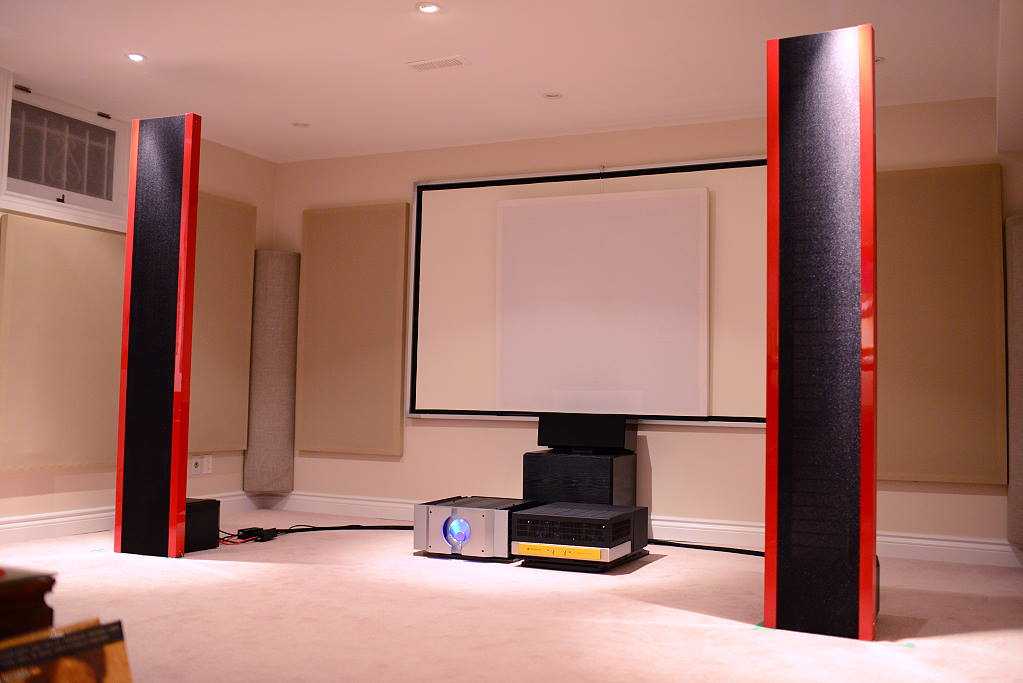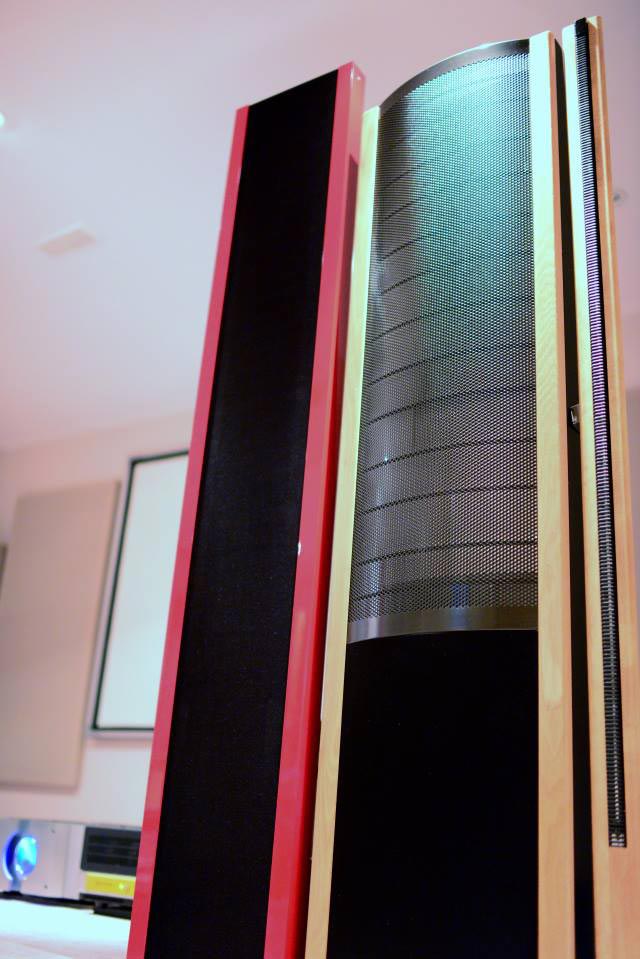Arriving at my friend’s home, we could barely get the coffins through the door. Luckily, they only weigh approximately 80 lbs, despite being bulky. We moved the speakers into place, positioning them approximately 7` apart, 32” from the front wall, and toed-in at a 15° angle. The listening position was approximately 13 feet away. Associated equipment included a JC Verdier Turntable, an Esoteric K-06 SACD/CD Player, and a Pass Labs INT-150 integrated amplifier.
The P3.1’s sensitivity is rated at 84 dB. With the Pass Labs INT-150, I had to turn volume up to a reading of 50 to get an equivalent volume at the 35 level on the dial when the amp was driving the Dynaudio Special 25 which previously occupied the spot. 84 dB is fairly inefficient and will require some muscle, yet with only 150 Watts of output, the sound quality improved compared to what I heard at my house. The speakers sounded much livelier in this room, with a stereo image which was complete and without any hollowed out areas. The Audio Exklusiv 3.1 panels were beginning to sing!
On the plus side, the panels came to life when the volume dial was cranked up. The P3.1s love to be played loud, albeit not in my system. When I played demo drum tracks, such as “Swing Rhythm” from the Usher Audio Demo CD, “Earth Drum” from He Xun Tian’s Paramita CD, and “Warriors of Heaven & Earth” of the movie soundtrack by A.R. Rahman, the P3.1s produced earth shattering bass which was deep and thunderous, putting out prodigious bass which you can both hear and feel. In this system, this German redhead sure can sing bass, so much so that on a bass heavy track at a loud volume, it began to overload the living room. On the minus side, it is possible that the 150 watts Pass Labs Integrated amp does not have enough juice to drive these panels because the bass, despite being plentiful, was lo0se and not well controlled. Some lower level dynamics and bass texture were missing, dynamically the lower level signals seem to be truncated and not well defined, which strongly suggest the speakers require more power, which means this is a matching problem with the amplifier and the speakers.
On the right acoustic music, like Nils Lofgren’s “Keith Don’t Go” track from Acoustic Live CD, the string of the acoustic guitar was crisp and clear. The P3.1 possesses all the best attributes of electrostatic dipoles, massive soundstage with instruments floating in mid-air, transparency, crispness, clarity and immediacy. Alison Krauss’ “Forget About It” track, with string instruments including fiddle and dobro, also showed off the strength of the electrostatic panels. The sound stage and imaging were sharp and precise, but the P3.1 also has the drawbacks common to all electrostatic speakers, namely that they are extremely sensitive to positioning. Despite Audio Exklusiv’s claim that they have developed a special circuit which creates a cylinder wave with improved radiating patterns, the sweet spot is smaller than your normal speaker with cone drivers. If you move your head one foot to the left or right , the soundstage collapses into the corresponding left or right speaker. But when you are in sweet spot, you are in for a real treat because the level of transparency and 3-D holographic imagery is tough for cone speakers to match.
Despite the obvious improved performance, I still feel I wasn’t doing them justice because the P3.1s were underpowered by an integrated amp. The room, albeit much more manageable than my living room, is irregularly shaped and does not provide side wall reinforcements to the speakers. By now it should be obvious why I said my affair with the P3.1 was a rather complicated one. I had to pack the speakers for the second time as I had decided to take them to a third location.
This next room was shaped much closer to the golden ratio with the added bonus of the owner having a pair of electrostatics on hand for us to compare, the MartinLogan Request. He also has both solid state and tube amplifiers, namely the Pass Labs X250.5 and Sonic Frontier Power 2, both stereo amplifiers, respectively.
We first hooked up the Pass Labs X250.5, and the strengths of these full range panels were fully demonstrated right before my eyes. On Aglaja Camphausen’s “Why don’t you do right” (Meyer Records Vol 1, LC 09487), her voice hung in mid-air between and behind the two speakers with pinpoint imaging. Her voice was crystal clear and sharply focused. The plucking of the double bass strings could be felt with a distinctive “snap,” followed by bass notes which were clean, deep and adequate. Tonally, the midrange was neutral , without coloration, and with an emphasis on accuracy rather than musicality.
Just like at the previous two venues, the P3.1s love to be played loud. As we cranked up the volume on the song “Home”, (from the Album Up From Below, Edward Sharpe & The Magnetic Zeros, Community Records CSDLP-1138), the thumping of the drums blossomed with better definitions and spatial imagery. If you are looking for thunderous chest pounding bass attack, look elsewhere because the bass notes despite being clean and deep, will never have the kick and impact of cone drivers. Yet, the bass notes coming out of the Audio Exklusiv panels were probably the best I have heard from electrostatics speakers. They were deep, tuneful and voluptuous.
When the same songs were played via the Sonic Frontier Power 2 amplifier, the tradeoff between tubes and solid state immediately became apparent. While Edward Sharpe’s voice was rendered accurately without the slightest hint of coloration or distortion on the Pass Labs X250.5, it was decidedly more full bodied though less sharply focused with the tube amplifier. There was a much stronger organic character to the voice which made it more musical and pleasing to the ears. Bass performance, however, was even less solid with the tube amplifier. They were softer, woollier and carried less definition. While I much preferred the mid to upper frequencies on the tube amp, the boomy and inadequate bass performance made me want to go back to the Pass Labs X250.5.
Compared with the MartinLogan Request, the Audio Exklusiv P3.1 has the distinctive advantage of having a much more coherent presentation without any gaps in the frequency spectrum. The Martin Logan possesses the same airy and transparent qualities of the P3.1, but music was rendered with a noticeable timing difference between the upper and lower frequencies. Their apparent discontinuity to the sound is not that noticeable in and of itself, but become apparent when the two speakers were sitting side by side. While the Request gave an overall presentation with more body and weight, the P3.1 gave a more neutral and transparent sonic image with bass notes which were cleaner and faster.
If any, the weakness of the Audio Exklusiv P3.1 panels lie with the portrayal of acoustic space. Although there is plenty of bass when played with the Pass Labs X250.5, the bass notes do not decay as naturally as with a typical cone speaker. I played some piano tracks and Janos Starker’s solo cello tracks and the decay of the piano keys or the resonance of the cello cavity appeared to be shorter and with less harmonics. One of the tracks from Blue Coast Records – Finale — is a double bass solo which has a 10-second decay after the final note. On the P3.1 the decay is noticeably shorter. Perhaps these effects are nothing but unwanted acoustic colorations, the effects of these colorations are something which I would rather be with than without. However, these effects are associated with all electrostatic panels in general, and are not-specific to the Audio Exklusiv Panels.
Conclusion
My encounter with the Audio Exklusiv P3.1 electrostatic panel speakers has been both a love and hate relationship. I loved them because they are visually spectacular, they delivered sonic characteristics which are in line with my expectations. They are airy, transparent, clean and accurate. For the electrostatic speaker fans who are looking for something with a small foot print, yet with the ability to produce frequencies as low as traditional speakers with cone drivers, the P 3.1 is a strong contender in that small playing field.
But as you have just witnessed, you cannot just throw these speakers into any room and expect them to sing well. I almost had to get the stars to align before they would sing for me. If your room dimensions and size are not ideal, all bets are off. But if you have the time, money, and patience, this German Redhead may reward you handsomely.
- ← Previous page
- (Page 2 of 2)







A well-written, informative review. It tells me what I need to know, ie that for me and my tastes, these probably aren’t the right speakers. (The more polite and small room friendly Quad ESL 57s probably are, though – wish I hadn’t sold my pair)
And … could we stop comparing audio equipment to sexy women? We desperately need to grow this hobby, and typecasting ourselves doesn’t help. Thanks.